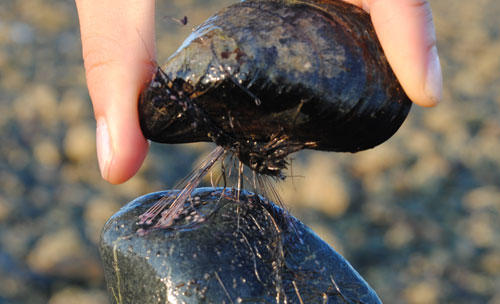
Mussel attached to a rock in the Boston area. (Courtesy: Zhao Qin)
By James Dacey
Ask any old sea dog and they will tell you the same thing – mussels are resilient little blighters that’ll cling onto yer ship no matter how fast ye sail. The secret behind the ability of mussels to remain tightly attached to surfaces has now been uncovered by a group of researchers at Massachusetts Institute of Technology (MIT) in the US.
Whereas barnacles fix themselves tightly to the surfaces of rocks, mussels deploy a different form of adhesion. They dangle from surfaces by a series of fine filaments known as byssus threads made from a protein closely related to collagen – a major constituent of skin and bones. The biological explanation for this behaviour is that it allows the mussels to glide through the water increasing the amount of nutrients they can absorb.
In drifting through the water, however, mussels expose themselves to the brute force of the sea – and therein lies the mystery. The strength of dynamical loading on the byssus threads is regularly more than 900% higher than the material’s strength under static loading. So why do these threads not snap?
This was the scientific question addressed by MIT’s Zhao Qin and Markus Buehler, who combined experimental work with computer modelling to reach an answer. They placed a batch of mussels into a cage and dangled this into Boston’s docks for three weeks, during which time the mussels attached themselves to the surfaces of glass, ceramics, wood and clay in the cage. Back in the lab, Qin and Buehler flexed their mussels – so to speak – under a range of different deformations.
By studying these deformations, the researchers came to realize that the properties of the byssal threads seemed to change along their lengths. They found that 80% of the thread was stiff, while the 20% closest to the body of the mussel was significantly softer and stretchier. According to the researchers, it is this combination of stiff and soft materials that enables the mussels to flex and dissipate the energy introduced by external forces.
What’s more, Qin and Buehler discovered that this 80:20 ratio appears to be very finely tuned – changing it slightly in the computer models revealed a rapid reduction in the tolerance of threads to external loads. The research is described in a paper published on 23 July in Nature Communications.
It seems that a spider’s cobweb-thread has a similar property of being partly hard and partly soft to survive the winds.